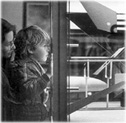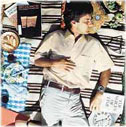
|
|
|
|
|
(continued) Charles and Ray Eames's goal in creating Mathematica was one shared by many others before and since: making math fun. Bryan Connell, the Exploratorium's manager of public programs, thinks the Eames's rare success at this goal derives from their love of the quirky, magical qualities of math. "They understood that the façade of rational order and dry abstraction conceals an exotic, freewheeling, imaginative dynamic . . . I think that's why [the exhibition] has stood the test of time." Created in an era before the invention of the personal computer and the widespread use of digital design tools, Mathematica anticipated the increasing activity and visual density of information age design. Mathematica, the Eames's first museum exhibition, signaled a shift in emphasis that characterized the last two decades of their careers: a movement away from material architecture and furniture design to information architecture and the design of learning environments. They would go on to create thirteen more exhibitions, the majority of them dealing with science. They also created dozens of films; Powers of Ten, their best-known, will be shown at the Exploratorium's McBean theater November 23-25. Look for more films and lectures focusing on design and the Eames's work in the spring of 2002. Oakland artist Bruce Cannon will be one of several artists contributing works that expand on the themes of Mathematica. In his sculpture, Ten Things I Can Count On, Cannon employs computerized counters to mark the passage of time relative to significant events. One counter tallies the number of breaths the artist has taken, while another estimates the breaths he has left. Yet another calculates the average time viewers spend considering the piece. With this work, Cannon's self-described goal is "to model the self-destructive futility of our compulsion to quantify." Legendary card stacker Bryan Berg will pay homage to the Eames's modular architectural tradition by building what promises to be a mighty house of cards inside the Exploratorium. Berg holds the Guinness World Record for crafting the tallest house of cards, a towering 24-foot structure built, like all of his constructions, without tape, glue, bending, or folding. At the Exploratorium, Berg will construct a weight-bearing house of cards, squat in stature but designed to support roughly four tons. For sheer goofiness, it's a stunt the Eames's would surely have enjoyed. To quote Charles Eames, "One of the best-kept secrets in science is how unpompous scientists are at their science, and the amount of honest fun that for them is part of it. In doing an exhibition, as in Mathematica, one deliberately tries to let the fun out of the bag." Mathematica: A World of Numbers and Beyond opens October 6. The exhibition is free with museum admission. ( previous page )
Mathematica...A World of Numbers and Beyond provided by the California Science Center. All images © Eames Office
|
|
||||||
|
|
|
|||||



